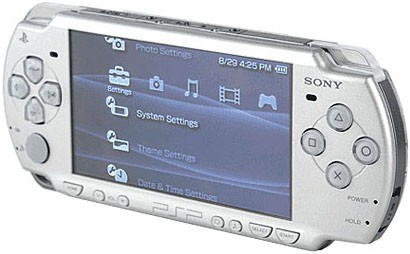 When Sony first announced an updated PSP at 2007's E3 show, a lot of people were straining to see what was so new about it. Indeed, from a distance, the new PSP is almost indistinguishable from its predecessor. But pick one up, and the differences are more apparent: it's thinner, much lighter, and sleeker than the original. It's also got a few other new tricks under the hood. The new PSP (which Sony calls "the PSP 2000," to delineate from the earlier "PSP 1000" model) will be available in North America on September 10 in two different versions: a black PSP-only package ($170) and the Daxter Entertainment Pack version, a $200 package that includes a silver PSP with the Daxter game, a Family Guy UMD video, and a 1GB Memory Stick Duo. A similar Star Wars Entertainment Pack will follow a month later (white PSP with black Darth Vader monogram and the Star Wars Battlefront Renegade Squadron game--but no MS Duo card included). Expect the bundle configurations to be updated periodically, along with the possibility of new colors at any time in the future.
When Sony first announced an updated PSP at 2007's E3 show, a lot of people were straining to see what was so new about it. Indeed, from a distance, the new PSP is almost indistinguishable from its predecessor. But pick one up, and the differences are more apparent: it's thinner, much lighter, and sleeker than the original. It's also got a few other new tricks under the hood. The new PSP (which Sony calls "the PSP 2000," to delineate from the earlier "PSP 1000" model) will be available in North America on September 10 in two different versions: a black PSP-only package ($170) and the Daxter Entertainment Pack version, a $200 package that includes a silver PSP with the Daxter game, a Family Guy UMD video, and a 1GB Memory Stick Duo. A similar Star Wars Entertainment Pack will follow a month later (white PSP with black Darth Vader monogram and the Star Wars Battlefront Renegade Squadron game--but no MS Duo card included). Expect the bundle configurations to be updated periodically, along with the possibility of new colors at any time in the future.What's different: Comparing the updated PSP to the original
If you're already familiar with the PSP, we'll cut right to the chase. The new PSP is an evolutionary upgrade, with the following key changes:
 Thinner and lighter: The new PSP is 19 percent thinner and fully one-third lighter than the original version of the console. Anyone used to the older PSP will immediately notice the reduced weight as soon as they pick it up.
Thinner and lighter: The new PSP is 19 percent thinner and fully one-third lighter than the original version of the console. Anyone used to the older PSP will immediately notice the reduced weight as soon as they pick it up.Slightly improved cosmetics and controls: The thinner profile offers a slightly sleeker, more rounded look and feel. Even better, however, is that all of the control buttons (the D-pad on the left, the PlayStation circle, X, square, and triangle on the right, and the shoulder buttons on the top) are all sitting a bit more elevated on the chassis' face. As a result, they have a bit more travel and spring to them. They feel just a tad more responsive--and that's a good thing.
Faster loading times: The new PSP utilizes a system setting called "UMD Cache" that enables faster loading of game discs. The secret is the new PSP's extra RAM--it's got 64MB versus the 32MB on the original model, and just like a PC, more memory enables faster performance. Many games do indeed load faster--while Test Drive Unlimited showed no real improvement in GameSpot's testing, Pro Evolution Soccer 2007 and WWE Smackdown vs. Raw 2007 both showed nice gains, for instance. But don't expect miracles: The UMD load times are still poky when compared to the lightning-fast, Flash-based games of the Nintendo DS and Game Boy.
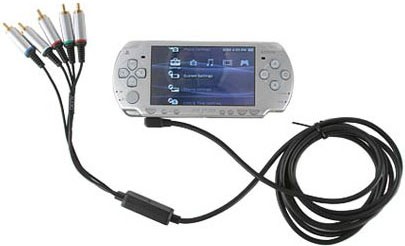
Video output to a TV requires a breakout cable (sold separately), and has a few important caveats.
USB charging: The new PSP can be charged via the USB port, but it's more trouble than it's worth. The resulting trickle charge will take about 5 hours to fully juice up the unit, versus about half that using the standard adapter. Worse, the unit needs to be on and connected to a powered-up PC, and you have to engage the USB mode (as you would when connecting to PC) in order to activate the charge process. If you really need USB charging, opt instead for the Kensington USB Power Tip--the sub-$20 cable lets you charge any PSP (new or old) from any USB-powered jack, including that of an iPod power adapter or the Belkin Dual USB Power Adapter.
 In other words, there are a couple of nice cosmetic improvements, but the USB charging and video output additions are something of a disappointment. (Perhaps some of the problems can be addressed via future firmware upgrades.) But demanding gadget fans will note that there's still plenty of room for improvement. Even without a radical redesign, the lack of a second analog stick and some built-in flash memory seems like a lost opportunity. Likewise, some persistent annoyances--such as the low volume levels and glossy fingerprint-prone screen--are frustratingly intact. And while it's more a political than a technical limitation, Sony's continued resistance to the homebrew movement seems shortsighted; we'd love to see the PSP be available as an open platform for third-party game and application developers without the need to hack it.
In other words, there are a couple of nice cosmetic improvements, but the USB charging and video output additions are something of a disappointment. (Perhaps some of the problems can be addressed via future firmware upgrades.) But demanding gadget fans will note that there's still plenty of room for improvement. Even without a radical redesign, the lack of a second analog stick and some built-in flash memory seems like a lost opportunity. Likewise, some persistent annoyances--such as the low volume levels and glossy fingerprint-prone screen--are frustratingly intact. And while it's more a political than a technical limitation, Sony's continued resistance to the homebrew movement seems shortsighted; we'd love to see the PSP be available as an open platform for third-party game and application developers without the need to hack it.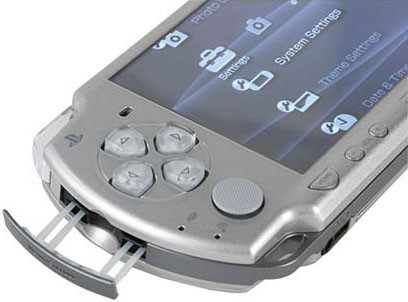
Design
Aside from the slimmer dimensions (169.4 x 18.6 x 71.4 mm) and lighter weight (about 200 grams with the battery, game disc, and Memory Stick on board), the new Sony PSP doesn't look much different from its predecessor. The luscious 4.3-inch wide-screen LCD display remains, bordered by controls on its left, right, and bottom side, plus two shoulder buttons along the top edge. The button layout is based on the classic PlayStation controller layout--four-way directional pad on the left, square, triangle, cross, and circle keys on the right--so anyone who's used a Sony console over the last decade should be able to pick up and play. The bottom left of the front face also houses an analog thumbstick, for more precise movement. More mundane media controls line the bottom of the screen: select, start, volume, brightness, and a "home" button.

The slimmer profile is immediately noticeable when compared to the old PSP.
Other changes from the old to the new: the UMD bay is now a bit more low-tech (instead of a sprint-loaded eject, you just pry open the chamber with your fingernail) and the Wi-Fi on/off switch is on the top edge (rather than the left side). And the headphone/AV jack is on the bottom edge, free of the obstruction of the handstrap loop. That doesn't sound like a big improvement, but being able to use any set of 3.5mm headphones--regardless of the size of the plug nub--is a nice contrast to the iPhone's annoying restrictive recessed headphone jack.
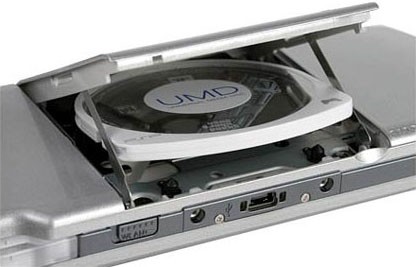
The Wi-Fi (WLAN) switch takes the place of the UMD eject button.
The PSP's interface is known as the Cross Media Bar, or XMB. If you've used the PlayStation 3, or even one of Sony's new high-end AV receivers or TVs, you already know what to expect: It's a pretty slick menuing system that's generally pretty easy to maneuver through using the D-pad and control buttons. As you get into some of the applications, however, that simplicity can get lost. We wished the Web browser, for instance, was as well-designed as the overall XMB menu system.
The USB port remains centered on the top edge of the PSP. Sony doesn't include a cable, but it's a standard mini-USB connector, so it's likely that you already have one lying around. The USB connector is flanked by two screw holes that allow for accessories to be firmly attached to its frame. But most people will use the USB port for quick connections to the PC to transfer digital media--photos, music, video, and even game demos available at Sony's Web site.
Multimedia and online features
The PSP is primarily a gaming device, but it's got some notable media functionality as well.
Video playback: The PSP can play videos from a variety of sources. The easiest--and most ill-advised--is to buy prerecorded UMD video discs. (With an extremely limited selection, and the fact that the PSP is the only place you can watch them, UMD videos are--not surprisingly--pretty hard to find.) A better--albeit more involved--option is to copy your own videos from a computer onto a Memory Stick Duo card, and pop it in to the PSP. A variety of free and commercial software products can convert files to PSP-friendly formats and resolutions (MPEG4 or H.264-AVC, up to 720x480). Other content sources include TiVo Series2 (the TiVo To Go Desktop software can convert recorded shows for viewing on the PSP) and dedicated flash media recorders, such as the Neuros MPEG-4 Recorder 2 Plus and the SanDisk V-Mate, which can be preset to record TV shows in PSP-compatible formats straight away, with no PC needed.
LocationFree TV: Built into the PSP is the ability to stream live TV from a Sony LocationFree TV device, which is Sony's take on the Slingbox. As long as the PSP is in a Wi-Fi hotspot, it can stream the video and change the channels on a LocationFree box, even if it's halfway around the world.
Audio playback: The PSP doubles as a decent music player, with the ability to play DRM-free MP3, WMA, WAV, AAC, and ATRAC3 files, along with support for album art. Shuffle and repeat modes are supported, along with a visualizer function.
Photo display: The PSP can display JPEG, GIF, and TIFF photos stored on the MS Duo card--individually, or as a slideshow.
PS3 "Remote Play": The PSP can log into a PlayStation 3 on a home network or via the Web, and stream any video, audio, or photos stored on the PS3. The PSP can also download and play some PlayStation Network game titles from the PS3 (mostly PlayStation 1 titles that have been rereleased specifically for that purpose).
Web browsing: The PSP has a built-in Web browser, but it's the one place--more than games--where you'll really lament the device's lack of a touchscreen (or even a numeric keypad). A lot of graphically rich pages will be cramped or broken on the screen, and the limited Flash support isn't particularly robust (no Flash-based video, for instance). That said, using the analog stick to control the cursor is nice, and any Wi-Fi connection is fair game (it can handle WEP and WPA encryption). And for a lot of people, it will be a better mobile Internet experience than they're getting on a phone. A separate RSS reader option is available, but it's a little more complicated than we'd like to add your own feeds.
Network update: The PSP has an upgradeable firmware, and Sony has been diligent about adding additional features, fixes, and updates every few months. The upgrade is as simple as choosing the option from the system menu.
Outside of North America, the PSP media options are even more robust: Japanese users have the option of a snap-on digital TV tuner for over-the-air broadcasts, while Europeans will soon have a video-on-demand service and VoIP communications. Likewise, Sony's international subsidiaries tout other PSP add-ons--a GPS device and a camera--that never quite seem to turn up in the US.
Can the PSP take the place of your iPod, iPhone, or portable DVD player? For die-hard media junkies--those with an 80GB iPod filled to the brim with music and videos--the answer is basically no. But if you're looking to travel with a few hours of music or some TV episodes, it makes for some nice diversion from a game, without having to lug a second device along. And while the screen isn't as large as you'd get with a portable DVD player, the PSP is decidedly less bulky--and its screen is considerably larger than that of the iPod or the iPhone.
Gaming
While its robust media and online functionality are impressive, for most buyers, they'll be decidedly secondary to the PSP's raison d'etre: Gaming on the go. Yes, Nintendo's DS remains king of the portable gaming scene in terms of units sold, but plenty of people are looking for more sophisticated (read: Less kiddie-oriented) games than the DS offers. And for those who can't abide the oh-so-cute antics of a Pokemon, Cooking Mama, Zelda, Mario, or Animal Crossing title, the PSP will be a welcome breath of fresh air. The graphics on the PSP are noticeably better than those on the DS as well--games are essentially at the level you'd expect on the PlayStation 2.
Early on, the PSP was knocked for being little more than the "PS2 portable," because so many of its titles were simply ports of PlayStation 2 games. And, indeed, its hit list is dominated by many PlayStation franchise standbys, including Grand Theft Auto, SOCOM, Tekken, and Burnout. But many of these are phenomenal titles that have been designed for the PSP from the ground up. Genre strong suits include sports, racing, action, and shooter titles, but it's not all sweat and blood, either--plenty of quirky puzzle games (Lumines, Puzzle Quest, Loco Roco) are available, as well as a host of family-friendly favorites as well (Daxter, Ratchet and Clank).
It's also worth noting that many of the PSP games include an online multiplayer component. Some games offer ad hoc multiplayer (peer to peer, for playing against other PSP'ers in the same room), others offer Internet play, or both. Online gameplay is free, and--while the experience varies from title to title and is dependent on network speed--it can be just as fun and fulfilling as playing on a home console.
Battery Life
To keep its slim figure, the new PSP has a flatter 1,200mAh battery than the more bulbous 1,800mAh one on the previous model. But, because it uses power more efficiently, it's actually rated for the same play time--3 to 6 hours of gameplay, or 3 to 5 of video playback. Going on a long flight? The more capacious battery actually fits into the battery bay, and offers several more hours of battery life--but the battery cover won't fit over the top of it. (Sony will be selling an extended battery kit, with the larger battery and proper cover.) The better battery life is welcome, of course, but PSP gamers will be disappointed--unlike that Energizer Bunny of gaming systems, you'll need to be juicing up the PSP more frequently.
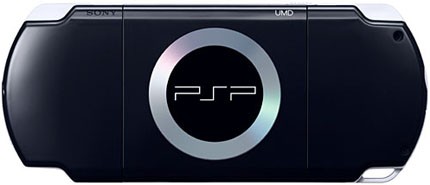
Is The New PSP For Me?
Someday, no doubt, Sony will debut a full-on PSP2, with a host of next-gen features and a more radical redesign. But for now, we've got an evolutionary upgrade of a portable gaming and media console that already had a lot going for it. Existing PSP owners won't need to run out and get this new version unless they really need one of the key upgrades--video out, lighter weight, or faster load times. Anyone else need only look at the available lineup of PSP games. If playing sophisticated, graphically rich versions of games such as Syphon Filter, Metal Gear Solid, MLB: The Show, and--in 2008--God of War is appealing to you, the PSP will ensure that you'll always be entertained. With its impressive game library, lower price, and expanded feature set, it's certainly a much better deal than the original PSP was when it debuted in 2005. And while its media and online functions won't necessarily replace a dedicated AV device or laptop, you may well find it to be good enough in plenty of situations.

2 comments:
Anonymous
September 10, 2007 5:40 PM
Anonymous
June 02, 2009 6:43 PM